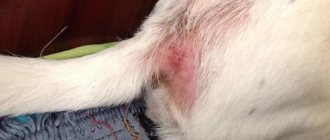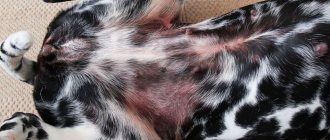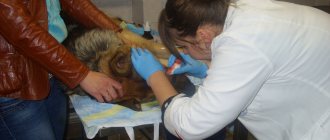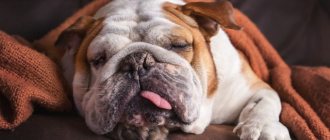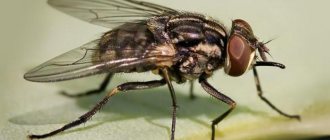Surely every person will be pleased to stroke his pet if he feels soft and pleasant fur under his hands. But, unfortunately, due to some health problems in dogs, their fluffy and pleasant fur can become greasy, matted into lumps, and also smell unpleasant. Seborrhea in dogs can cause such symptoms. This disease not only causes a deterioration in the appearance of the pet, but also leads to unpleasant sensations in the dog, as a result of which the animal becomes restless and lethargic. Unfortunately, it will not be possible to treat seborrhea in a dog on your own, since the disease requires complex therapy that will help eliminate the cause of the disease, as well as overcome the unpleasant signs of the disease. How to recognize the course of the disease, and how to properly treat seborrhea in dogs?
Causes of secondary seborrhea in dogs
Infectious diseases - causes of seborrhea in dogs
- Pyoderma
- Dermatophytosis
- Malassezia dermatitis
- Leishmaniasis
Allergic diseases of dogs - causes of seborrhea
Endocrine causes
Parasitic causes
- Demodicosis
- Scabies
- Cheyletiellosis
- Pediculosis
- Otodectosis
Dietary causes of seborrhea
- Dermatosis responding to treatment with vitamin A
- Dermatosis responding to zinc treatment
- Nutritional imbalance
Immune-mediated diseases causing seborrhea in dogs
- Pemphigus foliaceus
- Erythematous pemphigus
- Discoid lupus erythematosus
- Systemic lupus erythematosus
- Skin reactions to drugs
- Sebaceous adenitis
Metabolic causes
- Malabsorption
- Superficial necrolytic dermatitis
Tumor causes
- Cutaneous epitheliotropic lymphoma
Infectious diseases - causes of seborrhea in dogs
Allergic diseases of dogs - causes of seborrhea
Endocrine causes
Parasitic causes
Dietary causes of seborrhea
Immune-mediated diseases causing seborrhea in dogs
Metabolic causes
Tumor causes
How is seborrhea treated in animals?
How to treat dermatitis in dogs? To cure the disease, it is enough to use one of several treatment methods. These include:
Using Shampoo
Seborrhea shampoo for dogs will help completely cure the disease if it occurs at the initial stage of its development. The most famous shampoos are “Doctor”, “Elite”, “Globalvet” and so on. In order for the treatment of seborrhea in a dog, which can be identified from a photo, to be successful, you first need to comb the pet well and then apply shampoo to it, as written in the instructions.
If you wash your animal regularly with special shampoos, the disease will quickly disappear and skin health will be restored. If your dog is bothered by itching, you can wash your pet 2 times a day to relieve it.
Using antibiotics or ointments
Regional seborrhea can be cured if the owner uses special pharmaceutical drugs as treatment. When used correctly, you can quickly relieve your dog of discomfort and restore skin health. You can see the photo on how to properly apply the ointment or give your pet antibiotics.
The most well-known medications against seborrhea are: Zodak, Diprosalik and Cortisone.
Symptoms and treatment of seborrhea in dogs, which can be found in the photo, help to cure the disease in time, as well as restore the health of the pet. The main thing is to notice its signs in a timely manner so that dermatitis does not develop into an advanced form.
Treatment of ichthyosis as opposed to seborrhea
1. Purpose of polyunsaturated fatty acids.
These substances are found in large quantities in fish oil. 2
Local use of antiseborrheic shampoos, as well as products that are characterized by softening and moisturizing (vaseline oil, fatty creams). 3
Course use of retinoic ointment. The duration of such treatment can reach 4 months.
4. Intravenous administration of vitamin B12.
5. In summer, solar irradiation of a sick animal is indicated.
In winter, it is recommended to use ultraviolet irradiation. 6
Oxygen baths (oxygen therapy). 7
The prolonged course of ichthyosis in dogs is an indication for the use of hormonal drugs (prednisolone). Such medications can be used in the form of ointments or tablets but can provoke enterocolitis in dogs.
8. When secondary bacterial flora is added, the use of antibacterial drugs with a broad spectrum of action (penicillin) is provided.
Affected dogs are subject to exclusion from breeding. As a rule, the prognosis is unfavorable.
Clinical picture
In dogs, seborrhea usually affects areas of the skin that are particularly rich in sebaceous glands. Thus, in almost all cases, the skin along the spinal ridge suffers. In these cases, you can see not only greasy skin and fur, but also dandruff, which appears in the form of large flakes.
The dog's spine looks as if it has been caught in heavy snow. The skin may become noticeably red. Contrary to popular belief, with seborrhea, the epithelial layer does not always become greasy - sometimes it dries out noticeably, causing the skin of dogs with seborrhea to become scaly.
Seborrheic dermatitis is most severe in cases where areas with folds of the skin are affected, that is, legs, neck, armpits, and inner thighs.
In addition, the symptoms of seborrhea often involve the appearance of a heavy, unpleasant odor from the animal. As the disease worsens, when seborrhea is accompanied by bacterial and fungal infections, the “aroma” can become completely unbearable.
Genetically mediated form
Seborrhea of the dog's skin most often has a hereditary cause, although it cannot be said that another explanation has simply not yet been found. It is found in certain representatives of the canine world, American cocker spaniels, English bulldogs, basset hounds and dachshunds, and German shepherds. This is due, as mentioned above, to the excessive formation of epidermal scales, which is accompanied by increased secretion of fat. The skin ceases to perform its functions. As you know, this is the respiratory and excretory system, which works on a par with the internal organs.
Types of seborrhea
There are 2 main types of seborrhea in dogs: oily and dry. Most animals show signs of both types of seborrhea at the same time.
With seborrhea, the skin begins to secrete an excess amount of sebaceous, oily substance, which accumulates in the ears and armpits of the animal, as well as in the lower abdomen, on the elbows and around the ankles.
Due to excessive fat content, this substance has an unpleasant odor. Dogs tend to scratch seborrhea-affected areas, which leads to bleeding, scabs and hair loss, and can also lead to secondary infections due to skin damage.
Secondary seborrhea
Sometimes at the first stage the owner does not pay attention to the fact that his pet has problems with his fur. However, most often the symptoms of seborrhea in dogs develop rapidly. It easily turns into dermatitis, sometimes purulent. Most of the dog's skin is affected, but the head, ears, groin, interdigital areas and skin folds are primarily affected. Then the symptoms increase in severity. Itching leads to scratching of the wounds and the introduction of additional infection into them.
Where do legs come from?
When you first hear the term “seborrhea in dogs,” a person may think that we are talking about basic dandruff. In fact, this phenomenon has much more serious reasons, and it manifests itself in quite a variety of ways. This is a disease whose nature is sometimes not determined. There is evidence that the disease may be genetic in nature. However, this does not answer the question why seborrhea in dogs of the same breed and even those coming from the same nest can bloom wildly or not appear even once during their lives.
Signs of acral dermatitis
A disease such as seborrhea can cause inconvenience not only to humans; it has recently affected domestic animals very intensively.
Seborrhea in dogs is considered to be a skin disease accompanied by a special unpleasant “dog” odor. Seborrhea is accompanied by a violation of the keratinization of the skin (in the cells of the epidermis there is a disruption in the formation of keratin in the dog, which in turn protects the skin from mechanical injuries).
If your pet smells strongly of dog, even immediately after you wash it, and also itches constantly, then it may have seborrhea. In dogs, this disease is severe, and it is often accompanied by secondary bacterial infections and inflammatory processes.
The general definition is as follows. This is a pathological skin disease that is associated with a disruption in the formation of the stratum corneum.
It is also characterized as hyperfunction of the sebaceous glands, which is accompanied by increased secretion of fat. This can be seen even with the naked eye. If we clean the skin, we will see that it is slightly reddened.
Fat and loose epidermis often turn into a crust. Seborrhea in dogs most often develops further, so it is divided into primary and secondary.
Moreover, the sooner you start treatment, the greater the chance that you will be able to prevent complications.
With this form of dermatitis, thickening or ulceration may be visible on the back of the paws in the wrist area. Plaques can be found on the ankles and sometimes even between the toes.
The main symptoms of seborrheic dermatitis in dogs:
- The characteristic dog smell emanating from stray animals may also be present in a pet when it develops seborrhea.
- Matte wool shade. Usually the coat is shiny, but with this disease it immediately becomes dull.
- The fur is brittle, which causes excessive hair loss.
- Dandruff in huge quantities, visible to the naked eye.
- Itching is accompanied by constant sniffing of the animal.
- Black spots on the skin.
Therapeutic measures
To improve the condition of the skin and coat, special shampoos containing tar, salicylic acid and sulfur are used. If the diagnosis reveals a lack of nutrients in the body, vitamin supplements are prescribed.
Antifungal (Fluconazole) and antimicrobial (Ceftriaxone) agents can also be prescribed. Treatment with corticosteroid medications can be used to relieve itching.
Particular attention should be paid to the dog's diet. The veterinarian can choose the diet. It should contain the necessary nutrients and not cause allergies in the pet.
Rules and methods of treatment
The primary form of the disease cannot be completely cured. Therefore, its therapy should be aimed at suppressing symptoms and improving the animal’s condition. In the case of secondary seborrhea, the main task is to localize the causative disease.
Shampoos
There are special antiseborrheic shampoos that help soften the scales and remove them from the skin. The composition may include active components such as tar, salicylic acid, sulfur. They are applied in small quantities to damaged skin and left for 10-15 minutes. After this, rinse thoroughly with running water. After the skin and fur are dry, the remaining scales are completely removed.
Shampoos for dry seborrhea:
- Globalvet,
- Elite,
- Medicinal.
For oily seborrhea use:
- Tropiclean,
- Doctor.
After using shampoos against dry seborrhea, it is recommended to apply moisturizers with natural oils to the skin.
Ointments
You can treat the skin with external agents only after removing the scales. For severe itching, it is recommended to use Zodak. Diprosalik ointment helps relieve redness and accelerate skin healing. In severe cases, hormonal ointments (Cortisone) are applied. They quickly relieve itching, inflammation, and normalize the functioning of the sebaceous glands.
Systemic therapy
Seborrhea can occur against the background of other pathologies. Therefore, its treatment should be carried out comprehensively. Often it is necessary not only to apply external agents, but also to take systemic medications.
If a fungal infection is detected, the following is prescribed:
- Ketoconazole,
- Fluconazole.
In the presence of bacterial microflora, antibiotics are used:
- Ceftriaxone,
- Azithromycin.
Also, to maintain the normal condition of the dog’s skin, medications based on zinc and vitamin A are prescribed. If therapy does not bring the desired result, it is recommended to use corticosteroids. These are the best means to date for normalizing sebum production, eliminating itching and inflammation.
Specifics of caring for a pet
Everyday care of an animal with signs of primary seborrhea involves organizing its proper nutrition. The daily nutritional diet of a sick dog should contain natural supplements and vitamins that stimulate the metabolic processes occurring in the skin.
A pet with seborrhea must be prescribed a special diet, which must be followed for the rest of its life. It is advisable to agree on the diet with a veterinarian, who will help you adjust it taking into account the tests obtained. Since any deviation from the diet agreed upon with a specialist can lead to an exacerbation of the disease, its violation must be excluded.
In conclusion, we note once again that the so-called “genetic” or primary seborrhea is considered a practically incurable disease. As a result, the dog owner can only partially alleviate the condition of his pet and prevent the formation of infections of secondary origin. With timely and well-organized care, your pet will remain in excellent health and will not show any signs of concern from the problem.
Symptoms of the disease
Symptoms of seborrhea in dogs are
- Dull and matte coat
- Unpleasant, foul odor, “dog” odor
- Dry wool
- Follicular casts
- Excess dandruff
- Scaly and crusty skin
- Plaques on the skin
- Oily skin and coat
- Change in skin color
- Black skin, black spots on the skin
- Skin pigmentation
- Itchy skin
Most of the body is affected. However, the most severely affected areas are the perineum, head, armpits, lower side of the neck, interdigital areas, abdomen, and skin folds.
Itching can range from mild to intense and is often accompanied by ceruminous otitis externa. Often complicated by secondary infection with bacteria and Malassezia.
Despite the fact that dermatitis has many different causes, the symptoms of the diseases are similar. The danger lies in the subtlety of the signs in the first stages, if the dog is not white or has always been in excellent health. Most types of dermatitis can be recognized by the following symptoms:
- spots with redness on the skin;
- peeling;
- vesicles (bubbles with liquid);
- itching;
- a sweetish and unpleasant odor from the skin, a separate area of it;
- redness or hair loss;
- the dog is constantly itching;
- There may be a depressed state, irritability.
Damaged areas of the skin in some cases have an increased temperature. If bacteria get on the wound, then “pimples” with purulent contents or discharge of pus are observed. Also, dermatitis is often characterized by discharge from the eyes, redness of the mucous membranes, and whites.
The clinical picture of the disease can be observed with the naked eye in dogs from the puppyhood period. In this case, the symptoms may be completely insignificant, but over the years they can only worsen, becoming more and more noticeable, in addition, they can worsen if some other disease contributes to this phenomenon.
The appearance of seborrhea in a dog should be noticed by the appearance of the following signs:
- The fur becomes dull or dull in color.
- Sudden appearance of foul dog odor.
- Your pet's fur becomes dry and brittle.
- Follicular casts and a huge amount of dandruff are visible to the naked eye.
- Small wounds and crusts appear on the animal's skin.
- The skin and coat acquire a greasy, unhealthy shine.
- The animal is constantly itching because it is constantly itching.
- Black spots begin to appear on the pet’s skin, or it may completely turn black, and so on.
When a dog develops seborrhea, most of its body is affected by this disease. The disease likes to affect the perineal area, head, skin folds and abdomen.
The dog begins to constantly experience itching, occurring in mild and intense forms, which is also quite often accompanied by a disease such as ceruminous otitis externa.
Symptoms of seborrhea in dogs are
Most of the body is affected. However, the most severely affected areas are the perineum, head, armpits, lower side of the neck, interdigital areas, abdomen, and skin folds.
Itching can range from mild to intense and is often accompanied by ceruminous otitis externa. Often complicated by secondary infection with bacteria and Malassezia.
If traces of flea bites appear on the pet’s body, and upon careful examination the parasites themselves are found, then dermatitis will be called flea dermatitis. Its main features are as follows:
- Dog biting the skin.
- Itching and scratch marks on the skin.
- Wounds due to injury to the skin by animals during scratching.
- Loss of appetite, vomiting, problems with stool and stomach.
- Balding areas of skin, partial hair loss.
- Variable behavior: barking, occasional whining, irritability.
Signs and symptoms
For whatever reasons, seborrhea occurs in dogs, its manifestations are almost identical. Characteristic symptoms of the disease:
- dullness and dullness of the coat, loss of shine,
- dry skin, loss of elasticity,
- change in shade, appearance of permanent spots on the skin,
- severe flaking, the appearance of white or yellow-brown dandruff of varying sizes,
- the appearance of follicular casts due to sebum secretion,
- excessive oiliness or, conversely, dry skin and coat,
- specific smell of “dog”,
- the appearance of crusts on the skin,
- brittle claws,
- permanent itching.
Symptoms of seborrhea can be found on any area of the skin, but more often the disease progresses:
- on the ears,
- on the head
- in the groin area,
- in the interdigital space,
- in skin folds.
On a note! Due to itching, the dog scratches the skin, which leads to hyperemia and damage. Dermatitis gradually develops. The skin becomes inflamed and without appropriate timely treatment can become infected with bacterial microflora.
General information
This is the name of a peculiar skin disease characteristic of dogs (although cases of its detection in cats are not so rare). The main problem with this pathology is the overactive secretion of the sebaceous glands (and sweat glands, although to a lesser extent - dogs have a tiny amount of them). Often accompanied by inflammatory phenomena, often complicated by secondary infections. In 77% of cases, secondary seborrhea occurs (appearing against the background of some other disease). This pathology is rarely primary; often its causes remain unidentified (idiopathic course).
Scientists suggest that this disease is hereditary , and there are genetically predisposed breeds. epithelium of the hair follicle or claws. It is most often diagnosed in American Cocker Spaniels, English Springer Spaniels, Dachshunds, White Terriers, Labradors and Golden Retrievers, and German Shepherds. So study the pedigree of the puppy you want to buy in more detail. The disease begins at a young age (usually <18–24 months) and usually progresses continuously throughout the animal's life. It should be noted that in approximately 17-24% of cases, the diagnosis of “seborrhea” is made incorrectly, since there are many other dermatological pathologies, the external manifestations of which are similar to the disease we are describing.
However, veterinarians should not be blamed for this: it happens that an animal actually has secondary seborrhea, but it somewhat “fades” against the background of the main disease. Your pet's skin may become covered with scabs and a thick layer of fat as a result of pyoderma, malassezia, or exposure to some aggressive chemicals. You should also not exclude trivial cases of food intolerance and atopic allergies (this happens often at home).
Therefore, one of the main goals of the specialist is to determine the reasons under the influence of which the animal’s fur acquired such an unpresentable appearance. And further. Until the root cause is precisely determined , one should limit oneself to only the most “mild” treatment methods, since otherwise the clinical signs of the underlying disease may be so blurred that it will be impossible to determine it. Let's consider predisposing factors:
- Diseases of the endocrine glands - inflammatory lesions of the thyroid gland, Cushing's disease, etc.
- Allergies.
- Parasites – fleas, ticks, scabies.
- Mycoses - Malasseziasis is especially dangerous.
- Dietary pathologies – poor nutrition, low content (or complete absence) of polyunsaturated fatty acids in food.
- Environmental factors (heat, stuffiness and high humidity).
- Obesity, often accompanied by hormonal imbalances.
- Diseases of skeletal muscles.
Seborrheic dermatitis in dogs: general information
Seborrhea in dogs is a pet skin disease that is characterized by the appearance of dandruff and a layer of fat on the dog's skin. Today, seborrheic dermatitis is most often observed in dogs, but the pathology also occurs in cats, although in this case it is milder.
The main problem of marginal seborrhea of the ears in dogs (the lesion also develops on other parts of the animal’s body) is increased activity of the sweat and sebaceous glands, which leads to the production of large amounts of fat. Although dogs have virtually no sweat glands, as the disease develops, fat is still released in large quantities, which leads to the appearance of symptoms of seborrhea.
Often, seborrheic dermatitis in dogs is accompanied by the development of inflammation or damage to the animal’s body by a secondary infection.
In the photo, seborrheic dermatitis in dogs looks like dandruff, but this phenomenon is more harmful to the health of the animal, since in 77% of cases the disease develops against the background of the activation of a certain disease in the dog. Therefore, seborrhea of the edges of the ears or body is often called secondary, that is, appearing against the background of the course of a particular disease.
Primary pathology rarely develops - doctors currently have not been able to identify the causes of the disease. Scientists believe that unfavorable heredity can cause seborrhea in dogs. Moreover, this only applies to certain breeds that have medium or long hair. Seborrhea of dog skin is especially common in the following breeds:
- Cocker Spaniel;
- Labrador;
- terrier;
- German Shepherds;
- springer spaniel.
Therefore, before buying a puppy, you need to carefully familiarize yourself with the breed in order to know what diseases it may develop.
Typically, the symptoms of seborrhea in dogs begin to actively manifest themselves at a young age of the animal - most often this occurs between 18-24 months. After this, seborrhea, as a rule, begins to progress, which occurs throughout the dog’s life.
Attention! In 17-24% of cases, dogs are diagnosed with seborrhea incorrectly, since today there are a large number of dermatological problems that often attack pets. Such diseases have the same clinical picture, so it is quite difficult to distinguish them from each other.
In this case, there is no need to blame the veterinarian, since sometimes the course of seborrhea of the edges of the ears in dogs occurs in a “muffled” form, since the main disease that caused its development occurs in a more pronounced form. Then, oily seborrhea in dogs can be characterized by the development of skin with scabs or a thick layer of fat.
In order for the treatment of skin seborrhea in dogs to be effective and quick, it is necessary to correctly establish the diagnosis, because the treatment of the pet directly depends on it.
Doctors say that the factors that influence the development of seborrhea in dogs are:
- the course of mycoses - malasseziasis is especially dangerous for dogs;
- diseases of the glands that are responsible for secretion - these include thyroid disease, Cushing's disease, and so on;
- development of food allergies;
- parasites that live on the animal’s body - mites, scabies, fleas, and so on;
- unfavorable climate for the animal - poor nutrition, low levels of fats and acids in food or their complete absence;
- obesity in an animal;
- diseases of the muscles or skeleton.
Such factors lead to the dog developing oily seborrhea, the signs of which can be noticed soon after the onset of the pathology. You can also familiarize yourself with them in the photo so as not to miss the development of the disease in your pet.
Diagnosis of seborrhea
It's nice to stroke your faithful dog, feeling his soft fur under your hands. But petting a pet whose fur is greasy, matted and frankly smells bad is not the best idea.
And if the point here is that the dog just rolled around in a garbage heap, that’s not so bad. It is much worse if it is seborrheic dermatitis in dogs.
Because the symptoms of both types of seborrhea are identical, a veterinarian cannot make a diagnosis by relying solely on clinical signs. To make sure, for example, that the dog is suffering from a hereditary form of the disease, you need to check and exclude any possible causes of secondary seborrhea.
If, after a thorough analysis of the patient’s medical history, any possibility of secondary seborrhea is excluded, a biopsy is necessary to be completely sure of the diagnosis.
Treatment of this disease can be systemic and local.
First of all, the veterinarian must conduct a series of studies to exclude primary diseases that could cause seborrhea. This may include a physical examination, examination of skin samples for the presence of parasites, fungal and bacterial cultures, stool analysis, blood tests (general, biochemical) to exclude allergies, endocrine diseases and digestive disorders.
A skin biopsy may be needed. The diagnosis of “primary seborrhea” (hereditary seborrhea) is made only after other diseases that can cause seborrhea have been excluded.
How it manifests itself
Dandruff forms under the fur; this is one of the most striking symptoms that can be detected with the naked eye. Moreover, it can be dry or oily. In addition, you can see that the coat has become dull, as if covered with dust. After cleansing the skin, you can find inflamed and reddened areas. Later, plaques and sores form on the skin, and the dog’s entire body emits an unpleasant odor. In addition, there is itching, brittle nails and thickening of the paw pads. Often the skin begins to crack.
How do symptoms appear?
The symptoms of seborrheic dermatitis largely depend on its specific form, but in any case, the owner may encounter the following manifestations of the disorder in his dog:
- unpleasant odor from the animal’s body, even if the owner recently bought a pet;
- thickening of the upper layer of skin, with its further peeling under mechanical influence on the surface of the body;
- fattening or, conversely, increased dryness of the coat, possibly with loss or change in coat color;
- brittle claws;
- thickening of the paw pads;
- inflammation of the body surface, with redness of the affected areas;
- severe itching, which is expressed in the dog’s constant scratching of its body;
- inflammation of the ear canal, with large formation of sulfur exudate.
Ulcers often appear on sebaceous skin, and if an infection gets on their surface, real open wounds can form. This complication of seborrhea requires urgent treatment using anti-inflammatory and antiseptic agents.
Important! Before making final conclusions about the dog’s condition based only on the listed symptoms, it is worth making sure that there are no other diseases with a similar clinical picture: the doctor must exclude ectoparasitic and endocrine diseases, hypersensitivity and metabolic disorders.
The described symptoms can be noticed on almost any part of the animal’s body, but in the initial stages of the development of the problem they are best seen around the dog’s ears, in the spaces between its toes, on the head and in the folds of the skin, which is especially typical for Shar-Peis and other breeds of dogs with similar external characteristics.
Treatment of seborrhea
In cases of simple, uncomplicated seborrhea, emphasis is also placed on washing the sick animal. You need to use products with a keratolytic effect (this is written in the instructions or directly on the shampoo packaging).
They contain sulfur, salicylic acid, selenium sulfide, propylene glycol, fatty acids and benzoyl peroxide. The advantage of these drugs is that they cleanse the surface of the skin and coat from fat, old cells, and wash away conditionally pathogenic microflora.
The skin becomes soft and greasy is eliminated. It should be taken into account that shampoos with a keratolytic effect may initially lead to increased hair loss: the dog will need to be combed thoroughly.
If seborrhea is of unknown origin, then it is quite difficult to treat. In this case, the course of treatment will be built on the basis of those activities that will be able to improve the animal’s health.
All his discomfort is alleviated by using special shampoos (for example, 8 in 1 Freshening Waterless Foaming Shampoo) that can cleanse the animal’s skin. These specialized tools are based on the following components:
- Salicylic acid.
- Sulfur.
- Tar.
- Benzoyl peroxide.
8 in 1 Freshening Waterless Foaming Shampoo
In the event that the disease was caused by a lack of certain substances in the body that are missing in the animal’s body, they are replenished with complexes of vitamins, mineral supplements and fatty acids.
Shampoos need to be easy on the dog owner's wallet as they will need to be used regularly over a long period of time.
If secondary seborrhea is detected, antimicrobial drugs (Ceftriaxone), antifungals (Ketoconazole, Fluconazole), corticosteroids (Dexafort) should be used. Corticosteroids are ideal for relieving an animal of itching and intense sebum production.
In the fight against a disease such as seborrhea, a huge place is given to the nutrition of a sick dog, namely the presence in its diet of all the substances necessary to maintain immunity. This drug is used only under the strict guidance of the attending veterinarian.
Many veterinarians are inclined to believe that seborrhea is an incurable disease, as a result of which the symptoms of this disease can only be suppressed.
Unfortunately, today there is no medicine that can cure primary seborrhea. This means that the only thing dog owners can do is control the disease.
To do this, they need to understand that measures to dull the symptoms of seborrhea will have to be taken continuously throughout the pet’s life.
If an animal suffers from primary seborrhea, the main remedy for their treatment will be special shampoos. Among the huge range of such medical products, you should choose based on the individual characteristics of your pet.
If your dog is suffering from the dry form of the disease, moisturizers may help. If the problem, on the contrary, is increased oiliness of the skin, it is necessary to use shampoos that control the sebaceous balance of the dermis and remove crusts from its surface.
Unfortunately, in some cases it is impossible to control the disease with shampoos and conditioners. Therefore, sometimes veterinarians prescribe additional drug treatment to their patients.
As already mentioned, in such cases, dogs often suffer from secondary infections. If the infection has already appeared, the dog is usually prescribed antifungal agents as well as antibiotics.
Improvement can also come from using special nutritional supplements that include omega 6 and omega 3.
Also, drugs that slow down the process of cell division can help with seborrhea. This is usually cortisone, which can change the rate of epidermal renewal.
In addition to this main function, this medication provokes atrophy of the sebaceous glands. The only, but no less serious, disadvantage of drugs of this type is the presence of an extensive list of side effects.
This is why cortisone is used only in particularly severe cases.
Vitamin A and retinoids (its derivatives) are also required to keep the skin in normal condition. Therefore, veterinarians often recommend using it for primary seborrhea.
If the desired effect is not achieved, pet owners can try using etritinade, a retinoid famous for its high effectiveness.
However, this drug also has serious side effects, including keratoconctivitis, which immediately disappears after taking etritinade.
Since it is impossible to cure idiopathic seborrhea, the therapeutic course is aimed at controlling the animal’s condition. Using special shampoos and conditioners will help cleanse the animal's skin, thereby alleviating its condition.
Medicinal shampoos typically contain sulfur, salicylic acid, benzoyl peroxide, and tar (the same ingredients used to make acne and dandruff medications for humans).
Your veterinarian will explain to you how to prepare the shampoo and how often you should use it.
Fatty acids, vitamins and mineral supplements will help compensate for the lack of certain substances in the body, if any. In case of secondary infections, it may be necessary to use antibiotics (tablets and ointments), antifungal drugs and even anti-allergy medications.
In some cases, the above is not enough, especially if the disease is very advanced. In this case, after using shampoo, ointment is prescribed.
Its choice depends on the clinical picture. “Zodak” effectively relieves itching, “Diprosalik” removes redness and promotes wound healing, “Cortisone” normalizes the functioning of the sebaceous glands.
1. Purpose of polyunsaturated fatty acids.
These substances are found in large quantities in fish oil. 2
Local use of antiseborrheic shampoos, as well as products that are characterized by softening and moisturizing (vaseline oil, fatty creams). 3
Course use of retinoic ointment. The duration of such treatment can reach 4 months.
4. Intravenous administration of vitamin B12.
5. In summer, solar irradiation of a sick animal is indicated.
In winter, it is recommended to use ultraviolet irradiation. 6
Oxygen baths (oxygen therapy). 7
The prolonged course of ichthyosis in dogs is an indication for the use of hormonal drugs (prednisolone). Such medications can be used in the form of ointments or tablets but can provoke enterocolitis in dogs.
8. When secondary bacterial flora is added, the use of antibacterial drugs with a broad spectrum of action (penicillin) is provided.
Affected dogs are subject to exclusion from breeding. As a rule, the prognosis is unfavorable.
So how to treat seborrhea in dogs? There are many ways and means that can give quite a positive effect in most cases.
Important! You must understand that the primary course most often implies an unfavorable prognosis. Simply put, the genetic background of the disease makes it practically incurable, since none of the methods of therapy practically works.
If secondary seborrhea is detected, antimicrobial drugs (Ceftriaxone), antifungals (Ketoconazole, Fluconazole), corticosteroids (Dexafort) should be used. Corticosteroids are ideal for relieving an animal of itching and intense sebum production.
A sick animal needs a balanced diet. The owner does not need to sit for days on end and rack his brains while creating a menu for his beloved pet.
The diet is prepared by veterinarians who not only promote the dog’s speedy recovery, but at the same time does not contain any allergic foods that are contraindicated for the animal.
Treatment of seborrhea in dogs, how and what is treated
Primary seborrhea is an incurable disease, so therapy is aimed exclusively at alleviating the animal’s condition. The dog is cut short so that the care products penetrate the skin better. Before using special products, the dog must be washed. Contaminants in the fur are washed off with a simple shampoo, and only after that can medications or special products be used.
The following drugs and cosmetics are used to treat seborrhea:
Antiseborrheic shampoo - applied to the skin and left for 10-15 minutes. The shampoo facilitates the removal of skin flakes by actively softening them. After use, the shampoo is thoroughly washed off and dead scales are removed from the skin.
It is recommended to use Tropicline dog shampoo for seborrhea.
The following shampoos are recommended:
- Tropiclin (USA), Doctor (Russia) – for oily seborrhea.
- Therapeutic, Agrovetzaschita, Elite (Russia), Globalvet (Denmark) - for dry seborrhea.
After using shampoos, special moisturizing conditioners with lanolin or oil are used.
Ointments. Used after removing scales from the skin:
- Zodak – relieves itching.
- Diprosalik - relieves redness, promotes healing of wounds and irritations.
- Cortisone - used for oily seborrhea to normalize the functioning of the sebaceous glands.
Systemic treatment consists of the use of antimicrobial and antifungal medications:
- Ceftriaxone.
- Ketonazole.
Antibiotics are used to destroy secondary pathogenic microflora that develops against the background of infection penetration into irritated areas of the skin. Along with antibiotics, the doctor prescribes drugs to maintain intestinal microflora.
Fortification – the use of preparations based on vitamin A and Zinc.
Important. The frequency of use of products and doses of drugs are prescribed strictly individually, focusing on the condition of the animal’s skin and test results. The disease must be monitored and medications used as needed to relieve symptoms. Excessive use of products can lead to worsening of the disease and deterioration of the skin condition. The correct interval for using funds is calculated strictly individually.
Important Notes
Unfortunately, seborrhea today is increasingly complicated by the development of Staphylococcus aureus, which is extremely resistant to almost all the drugs described above. Because of this, it is strongly recommended that before prescribing antibiotics, culture is carried out on a nutrient medium, since otherwise you can feed your pet with strong antibiotics for a month, which will have no effect.
In case of seborrhea, complicated by the development of pathogenic and conditionally pathogenic fungi and yeast on the skin, the animal must be regularly bathed using special shampoos containing ketoconazole or fluconazole. In addition to destroying fungi, such products relieve itching and remove a layer of excess sebum from the skin, which helps eliminate seborrhea directly within three to four weeks. You just need to remember that such shampoos should not be used for more than a month (and they are used no more than twice a week), since in this case the normal microflora of the skin is catastrophically disrupted, as a result of which it will take a very long time for the animal to recover from seborrhea.
And further. Since treating seborrhea, complicated by the development of pathogenic microflora, often takes a very long time, the animal will constantly receive a wide variety of antibiotics during this period. And this has a very bad effect on the state of the gastrointestinal tract. Dogs already have a very weak intestinal microflora, but antibiotics kill it completely. What can be concluded? It's simple - after a long course of treatment for seborrhea using antimicrobial drugs, it is necessary (without fail) to feed your pet with probiotics . This will avoid many problems in the future.
Therapeutic techniques in the presence of secondary infections
Treatment depends on how “clean” the seborrhea is, whether there are secondary or concomitant diseases, etc. So, to eliminate pyoderma, antibiotics are used that work well against Staphylococcus pseudintermedius. Examples of such drugs are the usual amoxicillin, but Amoxiclav at 13.75 mg/kg, as well as cephalexin at 20-30 mg/kg, cefpodoxime at 5-10 mg/kg, and lincomycin at 20 mg/kg have proven themselves better.
Ciprofloxacin 30 mg/kg, enrofloxacin 5-10 mg/kg, marbofloxacin 3-6 mg/kg have proven themselves to be excellent. In more complex cases, azithromycin 10 mg/kg is prescribed for a month. Doxycycline 5 mg/kg can be used once in combination with trimethoprim 30 mg/kg. A combination of clindamycin 11 mg/kg and chloramphenicol 50 mg/kg is also effective. All of these drugs are prescribed (on average) for a period of up to four weeks, but sometimes the therapeutic course has to be extended for a longer period.
About the correct selection of shampoo for seborrhea
It is important to know how the individual components of the shampoo work and whether they have any synergistic effects, since the overall effectiveness of the drug depends on this. When choosing a detergent that can be used to treat seborrhea, we focus on the following factors:
- Moderate activity of the sebaceous glands, the pet's coat looks almost normal.
- Noticeable secretion of sebum and visible oiliness of the coat.
- There is a clearly visible layer of grease and scabs on the skin, and the fur is very greasy.
- The animal emits an unpleasant odor, the fur is matted, greasy and oily.
It is very important for the owner to inform the veterinarian exactly what stage of seborrhea is observed in his dog. In moderate cases, mild shampoos with a low content of antibacterial and antifungal agents, with a pronounced moisturizing effect, are needed.
They are good because you can bathe a sick dog every day. Such products almost do not wash away the natural protective layer of the skin, which speeds up and facilitates the healing process.
The prognosis for seborrhea depends on the severity of the disease, the general condition of the dog after completion of treatment, and other factors. If the root cause of the disease has been accurately identified and eliminated, the chances of a relapse will be minimal.
If you or your veterinarian have doubts about the completeness of the cure, you will need to show your pet to a specialist at least once a quarter.
Some diagnostic tests may be necessary (especially if seborrhea was caused by hormonal imbalances).
Genetic diseases in cats
Why do they say “cats scratch your soul”?
Should you take your pet with you on vacation?
Differential diagnosis
Thus, the specialist will always focus on those symptoms that can indicate the exact cause of what is happening to the animal. Must be taken into account: age, breed, gender. The owner is required to have as complete a medical history as possible: when, how and after what alarming signs began to appear in his pet. Various allergies (atopic dermatitis) are a more likely underlying cause if the pet is between one and five years of age, while neoplasia (especially cutaneous lymphoma) is more likely if seborrhea begins in older animals, or even middle-aged pets.
The intensity of itching plays an important diagnostic role . If it is minimal, then the animal may have some problems with the endocrine glands. Demodicosis or sebaceous adenitis is also possible. If the itching is significant, it is necessary to first consider the possibility of allergies and ectoparasites. It should be taken into account that many infections, malassezia or pyoderma also cause severe “pruritus”. Thus, the absence of itching is the first “bell” that may indicate seborrhea.
It is necessary to identify the presence/absence of polyuria, polydipsia or polyphagia (increased urination, thirst and appetite). These signs do not indicate seborrhea, but serious kidney pathologies. It is also useful to take into account the presence/absence of a dog’s pregnancy or sexual heat, that is, seasonality is important. The veterinarian should know what food and in what quantities your pet consumes, whether you are giving him corticosteroids, antibiotics, antifungals, antihistamines, etc. In addition, it is important to take into account environmental factors (is there a possibility of the dog coming into contact with household chemicals, for example). Such a scrupulous approach to diagnosis is due, as we have repeatedly repeated, to the presence of many diseases, the clinical manifestations of which are very similar to seborrhea.
Correction of complications
What to do if your dog has advanced seborrhea? Treatment in this case will be more complex and lengthy, but it can also be very successful.
In this case, you will need to perform a procedure to remove hair and degrease the surface using alcohol-containing products. After thoroughly treating the affected area with swabs soaked in ethyl alcohol, it is recommended to lubricate it with brilliant green.
Similar actions are recommended for complications of eczema or purulent dermatitis.
Post Views: 230
Preventative tips
Prevention of dermatitis consists of a balanced diet, adequate walks in the fresh air and under the dim sun. To avoid diaper rash after washing, the pet is thoroughly dried.
If treatment is carried out, the response to medications is closely monitored. It is necessary to wash and comb your dog regularly, the frequency depends on the type of coat and the characteristics of the body.
Once every 2-3 months, regular dog shampoo can be replaced with a special one based on herbs or with the addition of Chlorhexidine or birch tar.
Important! A predisposition to dermatitis, especially allergic and seborrheic, is transmitted from the dog's ancestors. Therefore, sick pets should be excluded from breeding.
- Firstly, during pregnancy, childbirth and feeding puppies, the body of bitches weakens, and this impairs resistance to bacteria and infections.
- Secondly, the offspring will receive the same problems and will pass them on.
- The owner must constantly monitor the condition of the animal’s skin and fur so that the disease does not reappear.
- A recovered animal should be shown to a veterinarian at least 2 times a year.
- The owner must constantly carry out flea control, because fleas can also cause inconvenience to their beloved pet due to the appearance of itchy skin.
Disease prevention
As preventive measures, veterinarians recommend:
- balanced dog food;
- regular visits to the doctor for timely diagnosis of dermatological problems;
- preventive vaccination;
- removal of worms at least 2 times a year;
- use of special veterinary cosmetics and hygiene products;
- no stress.
When buying a puppy, it is important to study its pedigree and ask whether its closest relatives suffered from seborrhea.
If a pet is diagnosed with seborrheic dermatitis, the owner will have to carefully monitor the condition of the dog’s skin.
A characteristic feature of the disease is frequent relapses, in which the condition of the skin and coat worsens. Animals with this diagnosis are regularly shown to a specialist.
Diagnostics
This disease is extremely complex because it has hundreds of forms. If at the initial stage it is relatively easy for a veterinarian to determine what he has to deal with, then if a secondary complication is added to the main disease, it is much more difficult to deal with the problem and prescribe adequate treatment.
How is seborrhea diagnosed in dogs? Symptoms, the treatment of which will require constant attention from the owner, can be quite vague, so it is necessary to conduct a full examination by exclusion. First, an external examination of the dog is carried out in order to exclude the presence of fungi, parasites and bacterial contamination.
At the same time, the doctor must take urine, blood and feces tests to rule out problems with internal organs and hormones, which also sometimes affect the condition of the skin and coat. In some cases, doctors perform a biopsy of skin areas. If one of the diseases that served as the root cause is identified, the doctor prescribes a suitable treatment regimen. If no concomitant ailments have been identified, then a diagnosis of “primary seborrhea” is made.
How is the disease diagnosed?
Before thinking about how to treat skin pathology, you need to correctly diagnose the dog. First of all, it is worth noting that the symptoms and treatment of dermatitis are inextricably linked, because it is by the signs of the disease that it is possible to determine that the animal is developing marginal seborrhea.
To establish an accurate diagnosis, you should visit a veterinarian who has everything to conduct a full examination of the animal. It is especially important for the doctor to correctly determine the cause of the development of primary seborrhea, on the basis of which the veterinarian prescribes the correct treatment regimen.
To establish an accurate diagnosis, it is necessary to conduct a visual examination, with the help of which the dog’s skin is examined for the presence of fungus or other types of parasites on its surface, due to which the development of dermatitis occurs.
After this, tests should be taken from the pet, after processing which it will be possible to identify internal problems that are the cause of the development of the disease. Such analyzes include:
- donating urine;
- blood donation.
Sometimes marginal seborrhea is detected through a biopsy, which involves a thorough examination of a specific area of skin.
The symptoms and treatment of seborrhea in dogs are closely related, so in order to accurately identify the disease, you will need to conduct a complete diagnosis, thanks to which it will be possible to make the correct diagnosis and begin effective treatment of the disease.
